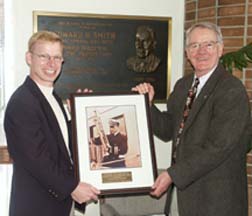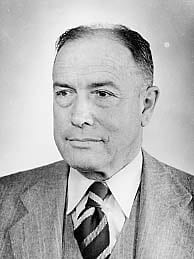US/Canada Joint Ice Working Group Meets in Woods Hole, Honors Contributions of Former WHOI Director Edward “Iceberg” Smith
June 11, 2002
The sinking of the R.M.S. Titanic in April 1912 had many connections to Woods Hole, the Woods Hole Oceanographic Institution (WHOI) and the US Coast Guard, the first the creation of the International Ice Patrol just two years after the sinking. The Woods Hole Oceanographic Institution gained international attention when it found the wreck of the sunken luxury liner in 1985 and explored it again in detail the following year. Many other connections exist as well, among them the major role of a former WHOI Director in ice research.
The deep roots between the Ice Patrol and Woods Hole were remembered recently during a visit to the Institution by the US/Canada Joint Ice Working Group, which coordinates international efforts associated with North Atlantic ice forecasts and reports. During their three-day meeting April 29-May 1 and visit to the Institution, Commander Robert Desh of the International Ice Patrol presented the Institution with a photograph of WHOI Director Edward “Iceberg” Smith, considered a giant in the ice patrol world. He served as third Director of the Institution from 1950 to 1956.
Edward Hanson Smith was born on Martha’s Vineyard in 1889, descended from a family of whalers. Smith spent a year at the Massachusetts Institute of Technology before entering what is now the Coast Guard Academy, then still known as the Revenue Cutter Service School of Instruction. He graduated in 1914 and a few years later had a chance to serve with the newly created International Ice Patrol (IIP), whose science advisor was Henry Bigelow, who later became the first Director of Woods Hole Oceanographic Institution. During World War I Smith served in the Europeon and Mediterranean theaters, and at the end of the war began studies of ocean currents and North Atlantic and Arctic weather conditions.
In November 1919, Smith was assigned as navigator and scientific observer to the Cutter SENECA, which left for IIP duty in the spring of 1920. His presence marked the first time a Coast Guard officer was detailed as scientific observer during a Coast Guard cruise, conducting experiments and observations for the advancement of oceanographic knowledge. In 1921 he began writing the annual report for the IIP, and in the off-season while he wrote patrol reports he studied under Henry Bigelow at Harvard University, completing a master’s degree in 1924.
By the early 1920s it became apparent that Coast Guard officers with professional oceanographic training were needed for IIP duties. The Coast Guard established an oceanographic unit at Harvard University in 1923 to provide support and conduct research for the IIP. From 1923 to 1931, the unit consisted of one civilian and one military oceanographer, plus five enlisted oceanographic technicians. The military oceanographer was Edward Smith, who, as a result of his annual IIP reports, was rapidly becoming known to his fellow officers as “Iceberg” Smith. In order to study ice more completely, it is said Smith brought chunks of it back to Harvard in the iceboxes of cutters. He would place a piece of berg or pack ice on the deck of a cutter and look at it for hours. At meals, he would stir the ice in a pitcher of ice water and study the melting ice and the eddies in the pitcher. To learn more about icebergs, he went with the MARION as far as 70° North, and was assigned to Woods Hole in 1933 to command Base 18 on the site of the present aquarium of the National Marine Fisheries Service. When the base was decommissioned the next year, he remained in Falmouth to write the well-known MARION report, which became his doctoral thesis from Harvard.
The value of Smith’s research to the safety of life at sea was soon recognized abroad by Norwegian shipping concerns, and Smith received an oceanography fellowship from the American Scandinavian Foundation. The Coast Guard granted Smith leave to study at the Geophysical Institute at Bergen, Norway, under the Norwegian oceanographer Bjerknes from 1924 to 1925. Upon his return, Smith regularized the investigations of the IIP under his own “practical method for determining ocean currents,” which was used to track the movements of icebergs. He also initiated a method of iceberg forecasting whereby the numbers of icebergs annually drifting south of Newfoundland were predicted.
Between 1928 and 1936, Smith was nominally the commanding officer of various vessels of the destroyer force the Coast Guard operated in suppression of alcohol smuggling, as well as commander of the base at Woods Hole, MA. Smith was able to maintain his career specialization even as resources were drawn away to enforce Prohibition. The Woods Hole Oceanographic Institution was established in 1930, and a year later the Coast Guard moved the oceanographic unit from Harvard to the village of Woods Hole. In 1934 Harvard University awarded Smith a Doctor of Philosophy in geological and oceanographic physics, the first doctorate in oceanography awarded in the United States.
During World War II, from 1940 to 1946, he was Commander of Task Force 24, the Greenland Patrol, whose staff included scientists from the Oceanographic Institution. For his work in saving Greenland from German domination, Smith was awarded the Navy’s Distinguished Service Medal. Following World War II, Smith was the Coast Guard Atlantic Area Commander at New York, where he also remained active in ocean research by serving on the staff of the Applied Physics Laboratory at Johns Hopkins University from 1946 to 1949. In 1947 he was instrumental in establishing the international weather ship system in the Atlantic and Pacific Oceans. Much of Smith’s career, from 1920 until his retirement from the Coast Guard as a rear admiral, was spent studying the oceanography of the Arctic and the North Atlantic.
In 1950, Smith retired from the Coast Guard and soon began a six-year tenure as Director of the Woods Hole Oceanographic Institution, where he had been elected a Member of the Corporation and a Trustee in 1945. During his term the research vessels BEAR and CRAWFORD were acquired, the Associates Program was established, the Laboratory for Oceanography and the Laboratory for Marine Sciences (now Redfield Laboratory) were built on Water Street, and the Institution established a formal education program. Many credit Admiral Smith with initiating the modernization of the Institution.
Cooperation between the Institution and the Coast Guard accelerated during Smith’s directorship as well. In 1955, the Oceanographic established a series of oceanographic observation outposts aboard Coast Guard lightships and light stations. For the next two decades, long after Admiral Smith¹s death in 1961, these dozen outposts recorded temperature and salinity measurements that in recent years have become one of the world’s most valuable databases for evaluating environmental phenomena such as global warming.
Admiral Smith died at his home in Falmouth on October 29, 1961, his 72nd birthday. The Institution’s Smith Laboratory, formerly the Laboratory for Oceanography, at 86 Water Street in Woods Hole is named in his honor.


